
|
Film Kisses of All Time in Cinematic History 1928-1932 |
![]()
| Film Title/Year and Description of Kiss in Movie Scene | ||

|
The Wedding March (1928)
Star/director Erich von Stroheim's melodrama was funded independently after the director had been ostracized by Hollywood studios for his extravagant film-making. Under a shedding apple-blossom tree in pre-WWI Vienna, there was a highly-romantic kiss between two lovers in a doomed relationship:
|

|

|
A Woman of Affairs (1928)
This MGM and Clarence Brown film was based upon Michael Arlen's erotic and controversial 1924 play The Green Hat, but sanitized for Hollywood. It told a non-explicit melodramatic story of a carefree woman engaged in numerous illicit and amorous love affairs when she was forbidden to marry her real love. It starred John Gilbert and Greta Garbo (real-life lovers) in their third film together (and last silent film) as self-destructive, star-crossed lovers:
In one of the most memorable scenes, Diana lounged seductively on a couch with a ring loosely dangling off her finger, mentioning coyly and temptingly to Neville that she would only take it off for the man she loved:
As they passionately kissed and she stretched back horizontally under his embrace, the ring fell (in closeup) from her finger to the floor. The film had a predictably tragic ending. |

|

|
Pandora's Box (1929, Germ.) (aka Die Büchse der Pandora)
G.W. Pabst's silent film classic starred Louise Brooks as the Insatiable, free-spirited, 18 year-old cabaret chorus girl and femme fatale Lulu. With a black bob (pageboy) haircut, was caught backstage in a wardrobe room scandalously kissing her obsessed and spell-bound patron - a wealthy newspaper owner named Dr. Ludwig Schon (Fritz Kortner). She was discovered by his more socially-acceptable fiancee Charlotte Marie Adelaide (Daisy d'Ora). Schon's marriage to his fiancee was immediately cancelled and he was compelled to marry Lulu instead, only to become jealously enraged by Lulu's flirtations with his son Alwa (Franz Lederer). Then, Schon was accidentally murdered on his wedding night (during their wedding reception) after struggling with a gun between them. Her final kiss was on Christmas Eve in London's Soho during an erotic embrace when she was killed by gleaming-knifed serial killer Jack the Ripper (Gustav Diessl) - her hand went limp to indicate her death. |
  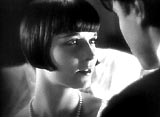 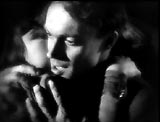
|
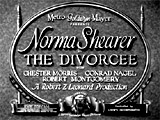
|
The Divorcee (1930)
This pivotal, brash Pre-Code film about divorce and infidelity featured Norma Shearer's Best Actress Oscar-winning role as a Manhattan ad writer with a man's name (Jerry) and a "man's point of view" who became a wayward 'loose woman.' The film was controversial at the time for its reversal of the hypocritical 'double standard.' When Jerry caught her unfaithful husband-newspaperman Ted Martin (Chester Morris) engaged in philandering and infidelity with an ex-girlfriend (the recently-divorced Janice (Mary Doran)), she matched Ted's unfaithfulness with her own sexually-adventurous, one-night stand tryst with their consoling, wealthy best friend Don (Robert Montgomery) after an evening of partying. When Ted stubbornly packed up and explained how his vanity and honor were ruined, she vowed to become more wanton, but by the film's conventional happy ending, she selflessly returned and was reconciled to her husband where he was working in Paris. They decided to take a second chance on marriage at midnight, during a New Year's Eve celebration at a nightclub:
|
 
|
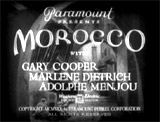
|
Morocco (1930)
In her Hollywood debut film (with Paramount and von Sternberg), Marlene Dietrich (as Amy Jolly) scandalously wore a sexually-ambiguous men's tuxedo and top hat as a performer in a North African cabaret club. In an early scene during which she exhibited smoky eroticism, she sang Quand L'mour, took a flower from the hair of a young lady in the audience (asking: "May I have this?"), inhaled it suggestively, and then kissed the woman full on the mouth. It was one of the earliest (if not the first) female-to-female kiss in cinema. After wild applause, the bisexual (or androgynous) chanteuse tossed the flower to admiring foreign legionnaire Tom Brown (a young Gary Cooper) in the audience. |

|

|
Mädchen in Uniform (Germany, 1931) (aka Girls in Uniform or Maidens in Uniform)
This landmark lesbian film from Germany with an all-female cast was the first movie to portray forbidden lesbian love. It was based on the play by Christa Winsloe about a lesbian relationship in a Prussian girls boarding school. US censors banned the film for its depiction of lesbianism between student Manuela (Hertha Thiele) and teacher Fraulein Elizabeth von Bernbourg (Dorothea Wieck). During a bedtime ritual in the dormitory in which all the schoolgirls were kneeling at the end of their beds and anticipating a goodnight kiss, the teacher kissed all the girls on the forehead, except for Manuela who received an intimate lip-kiss. |
 
|

|
Bird of Paradise (1932)
In this King Vidor-directed exotic tale, beautiful Mexican actress Dolores Del Rio (as Luana - an alluring native Polynesian princess) was rescued from a forced and arranged marriage by sailor Johnny Baker (Joel McCrea). The couple took up residence on a neighboring paradisical island, where they fell in love. They lived off the island's bounteous fruits and fishing, and resided in a thatched hut. She tempted her love interest to kiss her - repeatedly. She encouraged him by showing him where to put his lips. Later after they had rehearsed many times, their kisses were more romantic and frequent. |
 
|
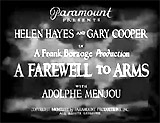
|
A Farewell to Arms (1932)
Ernest Hemingway's war-time novel was first made into a film with this Frank Borzage-directed romantic melodrama. The greeting kiss between World War I officer and ambulance driver Lt. Frederic Henry (Gary Cooper) and British nurse Catherine Barkley (Helen Hayes) was filmed with an impressive subjective camera close-up shot of her coming around his bed and kissing him after he first arrived in the hospital. The grateful patient responded: "You're lovely" and "You're the loveliest thing I ever saw." Another dramatic kissing scene was in the film's tearful conclusion when Catherine died in her hospital bed in a maternity ward in Switzerland after her baby died -- with Frederic by her side kissing her and professing his love:
In the scene, she experienced a prolonged tearjerking death:
Her words coincided with bells ringing to declare the Armistice. After she died, he carried her in his arms to the window and affirmed: "Peace, peace" - as white doves flew into the air and the screen faded to black. |
   
|

|
Love Me Tonight (1932)
This innovative musical masterpiece from Paramount and director Rouben Mamoulian told of a mismatched, commoner/rich girl romance between:
He pursued her into the garden of her family's chateau during a costume ball where she swooned with her eyes closed. He asked her to keep them closed, but she opened them and slapped him twice when he kissed her twice - but then she impulsively kissed and embraced him, and told Maurice that she loved him. He told her: "You don't know who I am...if I were not what you think I am..." although she professed that she didn't care: "You're you. And I love you...Whoever you are. Whatever you are. Wherever you are, I love you!" He replied:
|
  
|

|
Love Me Tonight (1932)
Director Rouben Mamoulian's musical-comedy romance was one of the most sophisticated and influential musicals of all time, with a wonderful score by Rodgers & Hart of songs that advanced the narrative. As the main in-love couple came together for a kiss in the film, flirtatious and charming Parisian tailor Maurice Courtelin /the Baron (Maurice Chevalier) recommended to the resistant Princess Jeanette (Jeanette MacDonald) as he was measuring her with a tape: "The important thing is not to hurry" - and then he aggressively kissed her. They were spied upon - and confronted in a compromising position with the Princess in her underwear, but Maurice/the Baron explained that he was only suggesting improvements to her riding costume:
|
  
|

|
Polly Tix in Washington (1932)
This notorious 15 minute child exploitation film was one of the Baby Burlesk shorts (with toddlers playing adult roles). Four-year-old Shirley Temple (in only her second film role) was featured as Polly Tix - a high-priced call girl/prostitute (!) sent by corrupt officials to influence a backwoods politician. |

|

|
MGM's and Victor Fleming's romantic drama starred Clark Gable as a sexy and unshaven Indochinese rubber plantation manager named Dennis Carson involved in a love triangle between two irresistible females:
During a torrential jungle rainstorm, Carson rescued Babs in his arms and "took" a kiss from her after reaching shelter. Jealousies surfaced soon after and Babs - in a jilted rage - resorted to wounding Carson with a shotgun, leaving him by film's end to be happily treated by Vantine during his recuperation. |
 
|
(in chronological order by film title) Introduction | 1896-1925 | 1926-1927 | 1928-1932 | 1933-1936 | 1937-1939 | 1940-1941 1942-1943 | 1944-1946 | 1947-1951 | 1952-1954 | 1955 - 1 | 1955 - 2 | 1956-1958 | 1959-1961 1962-1965 | 1966-1968 | 1969-1971 | 1972-1976 | 1977-1981 | 1982 1983-1984 | 1985-1986 | 1987 | 1988 | 1989-1990 | 1991 | 1992-1993 | 1994 1995 | 1996 | 1997 | 1998 | 1999 | 2000 | 2001 | 2002 | 2003 | 2004 | 2005 | 2006-2007 | 2008 | 2009- |